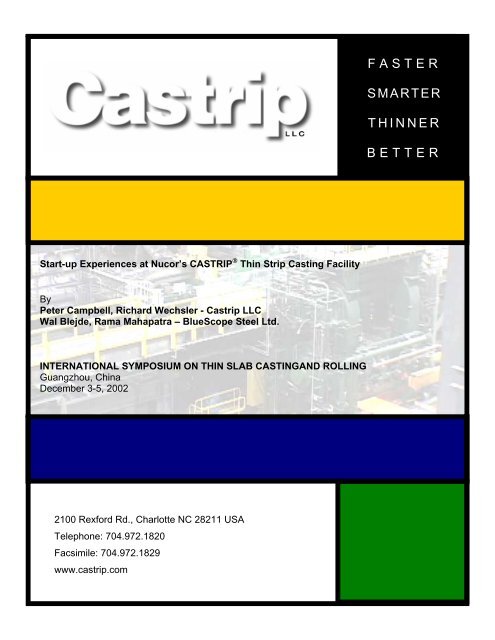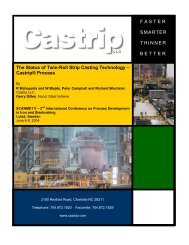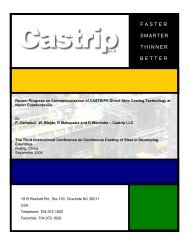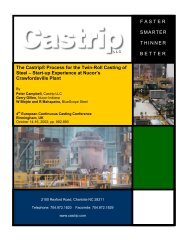tart-up Experience at Nucor's CASTRIP® Thin Strip
tart-up Experience at Nucor's CASTRIP® Thin Strip
tart-up Experience at Nucor's CASTRIP® Thin Strip
Create successful ePaper yourself
Turn your PDF publications into a flip-book with our unique Google optimized e-Paper software.
S<strong>tart</strong>-<strong>up</strong> <strong>Experience</strong>s <strong>at</strong> Nucor’s CASTRIP ® <strong>Thin</strong> <strong>Strip</strong> Casting Facility<br />
By<br />
Peter Campbell, Richard Wechsler - Castrip LLC<br />
Wal Blejde, Rama Mahap<strong>at</strong>ra – BlueScope Steel Ltd.<br />
INTERNATIONAL SYMPOSIUM ON THIN SLAB CASTINGAND ROLLING<br />
Guangzhou, China<br />
December 3-5, 2002<br />
2100 Rexford Rd., Charlotte NC 28211 USA<br />
Telephone: 704.972.1820<br />
Facsimile: 704.972.1829<br />
www.castrip.com<br />
FASTER<br />
SMARTER<br />
THINNER<br />
BETTER
S<strong>tart</strong>-<strong>up</strong> <strong>Experience</strong>s <strong>at</strong> Nucor’s CASTRIP ® <strong>Thin</strong> <strong>Strip</strong> Casting Facility<br />
Peter Campbell 1 , Gerry Gillen 2 , Wal Blejde 3 , Rama Mahap<strong>at</strong>ra 3 and Richard Wechsler 1<br />
ABSTRACT<br />
CASTRIP ® is a registered trademark of Castrip LLC<br />
1 – Castrip LLC, 2 – Nucor Steel, 3 – BHP Steel, USA<br />
On May 3, 2002, the first he<strong>at</strong> was delivered to Nucor’s CASTRIP ® facility <strong>at</strong> Crawfordsville,<br />
Indiana. This he<strong>at</strong> marked the s<strong>tart</strong> of the hot commissioning phase of the project following 12.5<br />
months of construction and 2 months of cold commissioning. The Nucor plant is the first, fully<br />
commercial strip casting facility, capable of casting both plain-carbon and stainless steel grades.<br />
At an annual capacity of 500,000 tons, the CASTRIP plant is expected to produce steel sheet<br />
between 0.7 and 2 mm, when fully oper<strong>at</strong>ional. Ramp-<strong>up</strong> of production <strong>at</strong> the plant is now<br />
taking place and the following paper provides details on the construction and oper<strong>at</strong>ion of the<br />
plant as well as some background inform<strong>at</strong>ion on the CASTRIP process.<br />
KEYWORDS - strip casting, twin-roll casting, CASTRIP ® technology, hot rolled coil, thin<br />
gauge hot rolled<br />
INTRODUCTION<br />
Near-net-shape casting of metal products has long been of interest to metallurgists and the metals<br />
industry. Obvious savings in equipment plus efficiencies rel<strong>at</strong>ed to hot and cold working as well<br />
as rehe<strong>at</strong>ing have been the main driving force. For more than a decade, BHP Steel and IHI<br />
(Ishikawajima-Harima Heavy Industries) collabor<strong>at</strong>ed on twin-roll casting design <strong>at</strong> development<br />
facilities in Wollongong, Australia. The codename for this venture was Project ‘M’ and the<br />
project covered labor<strong>at</strong>ory, pilot plant and full-scale development facilities. In 2000, Nucor<br />
Corpor<strong>at</strong>ion joined forces with the team, forming Castrip LLC, a joint venture company aimed <strong>at</strong><br />
commercializing the new technology. Construction is now complete <strong>at</strong> Crawfordsville, Indiana,<br />
also home to the world’s first thin slab caster. Hot commissioning and casting trials began in<br />
early May and the Nucor plant is expected to ramp <strong>up</strong> commercial production over the next 6 to<br />
12 months.<br />
For the past decade or so, strip casting of steels has been an interesting technical curiosity for the<br />
steelmaking community. Many projects and collabor<strong>at</strong>ive efforts have been initi<strong>at</strong>ed, practically<br />
worldwide; however none has been run <strong>at</strong> a full commercial level for extended periods. With the<br />
construction of the Nucor CASTRIP ® facility <strong>at</strong> Crawfordsville, the direct casting of sheet<br />
products will become a commercial reality. The following paper describes some of the key<br />
process fundamentals of CASTRIP technology and provides details on the first install<strong>at</strong>ion <strong>at</strong><br />
Crawfordsville. Physical properties for typical CASTRIP products are also included.
PROCESS OVERVIEW<br />
The CASTRIP process is based <strong>up</strong>on the same concepts th<strong>at</strong> Henry Bessemer p<strong>at</strong>ented in the<br />
mid-19 th century. Figure 1 shows a simple schem<strong>at</strong>ic of the basics of the process – two counterrot<strong>at</strong>ing<br />
rolls th<strong>at</strong> provide a surface or mold against which molten steel solidifies. As the figure<br />
indic<strong>at</strong>es, the steel begins to solidify against the rolls just below the meniscus and shell growth<br />
continues as it moves downwards through the melt pool. At the roll nip or pinch-point, the two<br />
shells are brought together forming a continuous strip, which then exits the caster in a downward<br />
direction.<br />
Counter-rot<strong>at</strong>ing Rolls<br />
Liquid Metal<br />
Solid <strong>Strip</strong><br />
Fig. 1 – Simple schem<strong>at</strong>ic of twin-roll strip casting process.<br />
Although the concept is extremely simple, its applic<strong>at</strong>ion <strong>at</strong> a commercially viable production<br />
level has proven to be extremely difficult. Several technical advancements have occurred in<br />
recent years th<strong>at</strong> have made twin roll casting possible <strong>at</strong> a commercial level. These include:<br />
High speed computing and process control<br />
Advanced ceramics and m<strong>at</strong>erials (including copper alloys)<br />
Sensing technology<br />
M<strong>at</strong>hem<strong>at</strong>ical modeling of physical phenomena<br />
A profile schem<strong>at</strong>ic of the Castrip facility is shown in Figure 2, indic<strong>at</strong>ing the main fe<strong>at</strong>ures of<br />
the process. The ladle and tundish are based on standard steel industry designs, as is the ladle<br />
turret (not shown). The tundish feeds a transition piece, which is situ<strong>at</strong>ed just above the delivery<br />
(core) nozzle. The caster does not use a dummy bar for s<strong>tart</strong>-<strong>up</strong>. Upon exit from the casting rolls,<br />
the solidified strip is directed to a pinch roll and then through a hot rolling stand. In this<br />
transition, the <strong>at</strong>mosphere is controlled to limit oxide form<strong>at</strong>ion on the strip. Equipment from the<br />
hot rolling mill through the coilers is of standard steel industry design.<br />
Additional detail on the development of the CASTRIP process, key process metallurgy<br />
breakthroughs, and product performance and applic<strong>at</strong>ions are provided in previously published<br />
papers. [1-4]
NUCOR’S CASTRIP PLANT<br />
Construction of the Crawfordsville CASTRIP facility began in February 2001. Fed from the<br />
existing EAF shop loc<strong>at</strong>ed less than 0.5 miles away, the CASTRIP caster building includes a<br />
ladle metallurgy furnace (LMF) to make the necessary temper<strong>at</strong>ure and chemistry adjustments<br />
prior to casting. Figure 3 shows a sketch of the general building layout indic<strong>at</strong>ing dimensions of<br />
approxim<strong>at</strong>ely 135 meters in width and 155 meters in length. The total length of the casting<br />
oper<strong>at</strong>ion, from ladle turret to coilers is only 60 meters. This is in contrast to a slab caster with<br />
rehe<strong>at</strong> furnace and hot strip mill th<strong>at</strong> typically requires 500 to 800 meters of length to make the<br />
same hot rolled products.<br />
Ladle<br />
Casting Rolls<br />
Controlled Atmosphere<br />
Tundish<br />
Transition Piece & Delivery Nozzle<br />
Hot Rolling Stand<br />
Cooling Table<br />
Pinch<br />
Rolls<br />
Shear<br />
Pinch Rolls<br />
Fig. 2 – CASTRIP process schem<strong>at</strong>ic.<br />
Coilers
155 m<br />
LMF<br />
ROLL<br />
PREP<br />
WATER<br />
TREATMENT<br />
P<br />
U<br />
L<br />
P<br />
I<br />
T<br />
135 m<br />
TURRET<br />
CASTER<br />
ROLLING<br />
MILL<br />
COOLING<br />
DOWN<br />
COILERS<br />
COIL<br />
STORAGE<br />
TUNDISH &<br />
REFRACTORY<br />
PREP<br />
ELECTRICAL<br />
SWITCH<br />
GEAR<br />
Ladle from EAF<br />
Fig. 3 – General layout of the Crawfordsville CASTRIP building.<br />
General specific<strong>at</strong>ions for the Crawfordsville CASTRIP facility are shown in Table I. Of<br />
particular note is the diameter of the casting rolls – 500 mm. This diameter is significantly<br />
smaller than other twin-roll casting projects and one of the main advantages of the CASTRIP<br />
process. Smaller rolls are less expensive to build, have a lower oper<strong>at</strong>ing cost and are capable of<br />
producing thin, high quality cast products. The CASTRIP process has the capability of casting<br />
steel strip <strong>at</strong> 1.0 to 2.0 mm in thickness, plus a single hot rolling stand to reduce the m<strong>at</strong>erial<br />
another 30%. At casting speeds of ~80 m/min and strip widths of 1345 mm and gre<strong>at</strong>er, the<br />
output of the plant is expected to be ~500,000 tonnes per year.<br />
Table I – Crawfordsville CASTRIP Plant Specific<strong>at</strong>ions<br />
Unit Specific<strong>at</strong>ion (in metric units)<br />
Building Dimensions 155 m x 135 m<br />
He<strong>at</strong>/Ladle Size 110 tonnes<br />
Caster Type 500-mm Diameter Twin Roll<br />
Casting speed 80 m/min (typical)<br />
150 m/min (maximum)<br />
Product Thickness 0.7 to 2.0 mm<br />
Product Width 2000 mm maximum<br />
Coil Size 25 tonnes<br />
In-Line Mill Single stand – 4 High with Hydraulic<br />
AGC
Unit Specific<strong>at</strong>ion (in metric units)<br />
Work Roll Dimensions 475 x 2050 mm<br />
Back-<strong>up</strong> Roll Dimensions 1550 x 2050 mm<br />
Rolling Force 30 MN maximum<br />
Main Drive 3500 kW<br />
Cooling Table 10 top and bottom headers<br />
Coiler Size 2 x 40 tonne coilers<br />
Coiler Mandrel 760 mm diameter<br />
Annual Capacity ~500,000 tonnes/year<br />
COMMISSIONING AND OPERATIONS<br />
The first he<strong>at</strong> was delivered to the CASTRIP plant early on the morning of May 3, 2002. Just<br />
over a week l<strong>at</strong>er on May 11, the line produced its first coil. Over the following months the plant<br />
increased its success r<strong>at</strong>e on casts and began to produce full-size, 20-ton coils and empty ladles<br />
on a regular basis. In July, the first commercial m<strong>at</strong>erial was shipped from the plant, to be used<br />
by Nucor’s Vulcraft division for structural decking. This m<strong>at</strong>erial had been side trimmed,<br />
pickled, cold rolled and galvanized <strong>at</strong> the Crawfordsville plant. Typically, two to three 110-ton<br />
he<strong>at</strong>s were delivered to the caster each day during the early phases of commissioning. Figure 4<br />
indic<strong>at</strong>es the number of ladles sent to the caster between l<strong>at</strong>e May and early August. As of the<br />
end of mid-August, 5000 tons of m<strong>at</strong>erial has been coiled.<br />
Weekly Casting Attempts (ladles)<br />
18<br />
16<br />
14<br />
12<br />
10<br />
8<br />
6<br />
4<br />
2<br />
0<br />
31-May 14-Jun 28-Jun 12-Jul 26-Jul 9-Aug<br />
Week Ending<br />
Fig. 4 – Ladles delivered to the CASTRIP plant since l<strong>at</strong>e May.<br />
During s<strong>tart</strong>-<strong>up</strong>, manning of the plant has been limited to two crews. In addition, BHP Steel, IHI<br />
and Siemens Energy and Autom<strong>at</strong>ion have had employees on site s<strong>up</strong>porting the Nucor crews.<br />
Each crew of 11 has responsibility from the LMF through coil handling of the finished product.
He<strong>at</strong>s arriving from the melt shop are tre<strong>at</strong>ed by the LMF prior to casting. Initially,<br />
commissioning was carried out 5 days per week, two 8-hour shifts each day. More recently, the<br />
crews have been running the plant on a 24-hour basis for 4 days per week to allow better pacing<br />
with the Crawfordsville melt shop. The 24-hour schedule is expected to enable 4 ladles per day<br />
from the melt shop to the caster. Over the next month or so, two additional crews will be added<br />
and the plant will step <strong>up</strong> to a round-the-clock oper<strong>at</strong>ing schedule, seven days per week.<br />
In addition to the low-carbon grade th<strong>at</strong> has been the main focus for Nucor’s construction<br />
markets, the Castrip plant has cast 409 stainless grades and very low-carbon grades for motor<br />
lamin<strong>at</strong>ion applic<strong>at</strong>ions. Initial trials with both grades were successful and subsequent he<strong>at</strong>s have<br />
been cast. In particular, 409 stainless has shown excellent castability with minimal change in<br />
practice, representing a potentially significant cost savings for the production of sheet 409<br />
products.<br />
At the time of writing of the paper, Nucor has limited shipment of the product to internal<br />
divisions. This is to provide close monitoring of the UCS (Ultra-thin Cast <strong>Strip</strong>) product and the<br />
applic<strong>at</strong>ions where it is utilized during early commissioning. More recently, orders have been<br />
placed from outside customers and these will be filled over the coming weeks and months.<br />
Photos taken during plant commissioning are shown in Figures 5 through 7. Figure 5 shows a<br />
view of the caster deck with the ladle rot<strong>at</strong>ed into casting position on the turret. The tundish and<br />
transition piece are directly below the ladle but obscured in this view by the <strong>up</strong>per level of the<br />
caster deck. The casting rolls are set in the lower level of the casting deck and m<strong>at</strong>erial flow of<br />
the solidified strip is from left to right. Figure 6 shows solidified strip emerging from the hot mill<br />
stand and on its way along the run out table to the cooling section of the line. Figure 7 shows a<br />
close-<strong>up</strong> of the sidewall of a typical UCS coil. Typically there will be a small amount of the edge<br />
trimmed from the coil.
Fig. 5 – Ladle on the turret, rot<strong>at</strong>ed into casting position <strong>at</strong> Nucor’s CASTRIP facility.<br />
Fig. 6 – <strong>Strip</strong> exiting the hot rolling stand during CASTRIP plant commissioning.<br />
Fig. 7 – Typical untrimmed UCS coil edge from the CASTRIP facility commissioning.
CHALLENGES AND NEXT STEPS<br />
As the plant moves from early stages of commissioning to more routine casting oper<strong>at</strong>ions, a<br />
number of key areas will <strong>at</strong>tract focus. Whereas early commissioning was focused more on the<br />
oper<strong>at</strong>ion of the process and full testing of mechanical, electrical, sensing and computer systems,<br />
in addition to training of oper<strong>at</strong>ors, the next phase will concentr<strong>at</strong>e on product quality, yield,<br />
throughput from the oper<strong>at</strong>ions and the cost of production.<br />
The product quality focus will be on maximizing the prime m<strong>at</strong>erial produced from the line. As<br />
was discovered during the development phase of the technology, a host of surface and internal<br />
defects can be cre<strong>at</strong>ed during strip casting. The methods for avoiding and elimin<strong>at</strong>ing these<br />
defects were also developed during the Project M work. Examples of finished coils produced<br />
during commissioning are shown in Figures 8 and 9.<br />
Oper<strong>at</strong>ionally, the challenges will be to work on establishing significant periods of plant<br />
oper<strong>at</strong>ion to determine the financial performance of the technology. Of key interest will be the<br />
metal-in-mold time achievable from the process, liquid metal to coiled product yield and overall<br />
oper<strong>at</strong>ing cost figures per ton. Discussions pertaining to expect<strong>at</strong>ions and the required levels for<br />
commercial success were discussed previously by Herbertson [5] and Wechsler et al [6]. In<br />
terms of the casting process and metal-in-mold time, the critical factors are the sequence length,<br />
the machine turnaround time and the reliability of the s<strong>tart</strong>-of-casting event. Performance during<br />
commissioning <strong>at</strong> Crawfordsville has indic<strong>at</strong>ed th<strong>at</strong> the Crawfordsville plant should <strong>at</strong>tain the<br />
minimum commercial hurdle r<strong>at</strong>es for each of these parameters. A two-ladle sequence has been<br />
performed already and the commercial minimum is projected to be three ladles. The machine<br />
turnaround time is dependent on the time required to change several of the main consumables in<br />
the casting process – namely the tundish, transition piece, side dams, core nozzle and casting<br />
rolls. The current machine design has a target time for a complete change of these components in<br />
less than 20 minutes. Recent experience has indic<strong>at</strong>ed th<strong>at</strong> this target is achievable. Finally, the<br />
s<strong>tart</strong> of casting procedure must become reliable, repe<strong>at</strong>able and routine. This will be a focus area<br />
in the coming months.
Fig. 8 – CASTRIP UCS coil banded and prepared for transit to finishing oper<strong>at</strong>ions.
Fig. 9 – The first galvanized coil of CASTRIP UCS product being prepared for shipment.<br />
CONCLUSIONS<br />
The commercial-scale production of steel sheet products via the twin-roll casting process has<br />
begun with the s<strong>tart</strong>-<strong>up</strong> of Nucor’s Crawfordsville CASTRIP facility. The production of fl<strong>at</strong><br />
rolled products utilizing the CASTRIP process has many advantages over conventional casting<br />
and rolling technology, including lower capital and oper<strong>at</strong>ing costs, reduced energy usage and<br />
emissions, thinner higher value products and a smaller, more flexible oper<strong>at</strong>ing regime. Further,<br />
due to its lighter gauges (< 1.5 mm) and excellent surface quality, CASTRIP products can be<br />
substituted for cold rolled sheet in many applic<strong>at</strong>ions and will likely cre<strong>at</strong>e a new product<br />
c<strong>at</strong>egory for fl<strong>at</strong> rolled sheet products known as UCS.<br />
REFERENCES<br />
1. K. Mukunthan, L. Strezov, R. Mahap<strong>at</strong>ra and W. Blejde, The Brimacombe Memorial<br />
Symposium, Vancouver B.C., 2000, 421.<br />
2. W. Blejde, R. Mahap<strong>at</strong>ra and H. Fukase, The Belton Memorial Symposium Proceedings,<br />
Wollongong, Australia, 2000, 253.<br />
3. W. Blejde, R. Mahap<strong>at</strong>ra and H. Fukase, Intern<strong>at</strong>ional Conference on New Development on<br />
Metallurgical Process Technology, METEC Congress, Düsseldorf, 1999, 176.<br />
4. W. Blejde, R. Mahap<strong>at</strong>ra and H. Fukase, Iron and Steelmaker, 27, No. 4 (2000), 29.<br />
5. J. Herbertson, Dr. Manfred Wolf Symposium, Zurich, 2002, 60.<br />
6. R. Wechsler and P. Campbell, Dr. Manfred Wolf Symposium, Zurich, 2002, 70.





